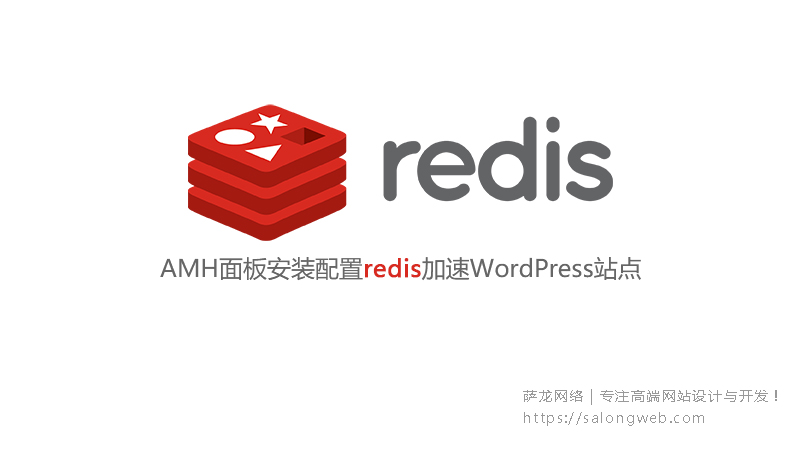AMH面板安装配置redis加速WordPress站点
 Redis是一个开源、支持网络、基于内存的key-value存储系统,类似memcached,性能极高,支持超过100K+ 每秒的读写频率,一些大型的网站例如ITeye(JavaEye)和CSDN现在都用到了Redis。
与memcached相比,Redis提供了持久化存储,重启了服务器后memcached需要重新创建缓存,而Redis依赖快照进行持久化,即使服务器刚开机启动也不会导致负载陡增。Redis缓存比较适合大流量的Wordpress。
当你的WordPress中的文章达到上万篇,随着流量的增加,Wordpress的服务器压力也随之不断加大,Wordpress发布文章和后台相关的操作都会变得缓慢,这时如果单从硬件上投入来提高Wordpress性能显然不划算。
利用Redis将WordPress页面直接缓存在服务器的内存中,这样在避免了PHP重复执行操作的同时,内存的极速响应能够最大限度地提升Wordpress页面的访问速度,实际测试发现页面执行时间可以降低到0.00X秒级别,比没有使用Redis缓存提升几倍甚至十几倍以上。
用Redis缓存来给WordPress站点加速-适用于Apache和Nginx。
Redis是一个开源、支持网络、基于内存的key-value存储系统,类似memcached,性能极高,支持超过100K+ 每秒的读写频率,一些大型的网站例如ITeye(JavaEye)和CSDN现在都用到了Redis。
与memcached相比,Redis提供了持久化存储,重启了服务器后memcached需要重新创建缓存,而Redis依赖快照进行持久化,即使服务器刚开机启动也不会导致负载陡增。Redis缓存比较适合大流量的Wordpress。
当你的WordPress中的文章达到上万篇,随着流量的增加,Wordpress的服务器压力也随之不断加大,Wordpress发布文章和后台相关的操作都会变得缓慢,这时如果单从硬件上投入来提高Wordpress性能显然不划算。
利用Redis将WordPress页面直接缓存在服务器的内存中,这样在避免了PHP重复执行操作的同时,内存的极速响应能够最大限度地提升Wordpress页面的访问速度,实际测试发现页面执行时间可以降低到0.00X秒级别,比没有使用Redis缓存提升几倍甚至十几倍以上。
用Redis缓存来给WordPress站点加速-适用于Apache和Nginx。
一、AMH面板上安装redis插件
如果你使用的不是AMH面板就使用SSH进行安装redis,在AMH面板需要安装redis+pecl_redis两个软件(支持PHP7),pecl_redis是AMH面板Redis软件的php环境扩展模块。下载安装好后,在应用软件中点击pecl_redis后面的管理,选择需要缓存的环境,安装即可。
二、用Predis.php作为Redis的PHP客户端
1、我们可以使用Predis.php来作为PHP客户端,直接将Predis.php下载并上传到Wordpress的根目录下,CD到Wordpress根目录,执行以下命令:
2、这是Predis.php的备份下载:Predis.php下载,手动下载并上传WordPress网站根目录下。
三、安装Redis前端缓存的PHP脚本
1、Redis前端缓存的PHP脚本来自:http://www.jimwestergren.com/wordpress-with-redis-as-a-frontend-cache/,为优化后的版本
- <?php
- $cf = 0;
- $debug = 0;
- $display_powered_by_redis = 0;
- $start = microtime();
- if ($cf) {
- if (isset($_SERVER['HTTP_CF_CONNECTING_IP'])) {
- $_SERVER['REMOTE_ADDR'] = $_SERVER['HTTP_CF_CONNECTING_IP'];
- }
- }
- define('WP_USE_THEMES', true);
- include("predis.php");
- $redis = new Predis\Client('');
- $domain = $_SERVER['HTTP_HOST'];
- $url = "http://".$_SERVER['HTTP_HOST'].$_SERVER['REQUEST_URI'];
- $url = str_replace('?r=y', '', $url);
- $url = str_replace('?c=y', '', $url);
- $dkey = md5($domain);
- $ukey = md5($url);
- (($_SERVER['HTTP_CACHE_CONTROL'] == 'max-age=0') ? $submit = 1 : $submit = 0);
- $cookie = var_export($_COOKIE, true);
- $loggedin = preg_match("/wordpress_logged_in/", $cookie);
- if ($redis->hexists($dkey, $ukey) && !$loggedin && !$submit) {
- echo $redis->hget($dkey, $ukey);
- if (!$debug) exit(0);
- $msg = 'this is a cache';
- } else if ($submit || substr($_SERVER['REQUEST_URI'], -4) == '?r=y') {
- require('./wp-blog-header.php');
- $redis->hdel($dkey, $ukey);
- $msg = 'cache of page deleted';
- } else if ($loggedin && substr($_SERVER['REQUEST_URI'], -4) == '?c=y') {
- require('./wp-blog-header.php');
- if ($redis->exists($dkey)) {
- $redis->del($dkey);
- $msg = 'domain cache flushed';
- } else {
- $msg = 'no cache to flush';
- }
- } else if ($loggedin) {
- require('./wp-blog-header.php');
- $msg = 'not cached';
- } else {
-
- ob_start();
- require('./wp-blog-header.php');
-
- $html = ob_get_contents();
-
- ob_end_clean();
- echo $html;
-
- $redis->hset($dkey, $ukey, $html);
- $msg = 'cache is set';
- }
- $end = microtime();
- if ($debug) {
- echo $msg.': ';
- echo t_exec($start, $end);
- }
- function t_exec($start, $end) {
- $t = (getmicrotime($end) - getmicrotime($start));
- return round($t,5);
- }
- function getmicrotime($t) {
- list($usec, $sec) = explode(" ",$t);
- return ((float)$usec + (float)$sec);
- }
- ?>
2、 你也可以直接点击备用下载:index-with-redis.php下载地址,再上传到WordPress根目录下。
3、 如果你正在使用cloudflare,请设置cf = 1; ,如果你想在页面上看到脚本执行时间和缓存加载时间,请设置$debug = 1; display_powered_by_redis = 1表示显示powered_by信息。
4、将index-with-redis.php上传到Wordpress的根目录,如果你使用的是nginx,重命令原来的index.php为任意其它名字,把index-with-redis.php重命名为index.php。
5、如果你使用的是Apache,则需要把.htaccess中出现的index.php替换成index-with-redis.php。
6、所有的操作完成后,你就可以刷新一下Wordpress页面,查看Redis缓存效果了。
四、Wordpress删除Redis页面缓存的方法
1、删除某一个页面的缓存:发表评论、按下F5刷新、在URL后面加上?r=y回车。
2、删除整站页面缓存:登录到Wordpress后台,在任意URL后面加上?r=y回车。
3、更新文章时自动刷新首页缓存:在你的Wordpress的Function.php中加入以下代码
- function newPostRefresh() {
- $temp=file_get_contents("http://xxxxxxx/?r=y"); //xxxxxx自己替换
- }
- add_action('publish_post', 'newPostRefresh');
- add_action('edit_post', 'newPostRefresh');
- add_action('delete_post', 'newPostRefresh');
- add_action('comment_post', 'newPostRefresh');
- add_action('edit_comment', 'newPostRefresh');
- add_action('delete_comment', 'newPostRefresh');
- add_action('wp_set_comment_status', 'newPostRefresh');
- add_action('switch_theme', 'newPostRefresh');
4、自动更新Wordpress缓存:在crontab中配置每10分钟用curl访问首页更新缓存,每天凌晨对首页或者分类页面进行更新,AMH可以安装amcrontab软件来进行设置。
- */10 * * * * curl http:
- 1 1 * * * curl http:
五、Wordpress Redis缓存使用小结
Wordpress Redis缓存加速效果无疑是明显的,特别页面多访问大的网站博客,在使用Wordpress Redis缓存加速时请禁止其它的所有缓存插件,以免造成不必要的冲突。经过测试Wordpress Redis缓存在使用过程中主要存在的问题就是文章更新时,相应的Tag和分类、首页等内容不会实时更新,我们需要手动更新或者利用自动更新命令。
文章来源:免费资源部落本文原创,作者:萨龙龙,其版权均为萨龙网络所有。
如需转载,请注明出处:https://salongweb.com/amh-redis-wordpress.html 一个平平常常的人,热爱生活、旅行和摄影,骑行去过西藏,一直计划再去。14年从江西骑行来到大理,现栖居于洱海边,食人间烟火,过简单生活,做简约设计!相信使用Wordpress的朋友都对WP-PageNavi分页插件不陌生,很多博客对它也有很多介绍,之前也使用过代码来实现分页,但不够人性化,使…WooCommerce是WordPress中最强大的商城插件,没有之一。在Slearn主题的开发过程中,需要将课程和商城结合,课程使用…同样是在开发吃货主题Chihuo,导航菜单中的二级菜单需要显示省份的小地图,也就是分类菜单中显示自定义的字段,我们可通过以下代码来实现这个功能。…用法
absint(mixed$maybeint)
将值转换为非负整数。
参数
$maybeint
(mixed)(必需)您希望…Wordpress的菜单都是通过后台菜单来添加设置,很多时候需要添加一些功能到菜单,比如搜索,或者购物车,这时我们就可以使用wp_nav_men…CodestarFramework,一个轻量且易用的WordPress选项框架,在萨龙龙最新设计开发的企业教育培训类WordPress…萨龙龙开发主题这么久,第一次感染恶意代码,整个WordPress下的主题functions.php都被插入了一大段函数代码,百度一下也发…在WordPress按角色获取可分页的用户列表并显示最新文章这篇文章中我们已经介绍了获取单个角色的用户列表,如果想获取多个角色的用户列表呢,ge…上一篇文章我们介绍了Isotope,功能强大,效果出众的jQuery插件,但是文章中的代码并不能使用在项目中,所以今天通过Wordpress主题…WordPress获取评论所有主题都是使用wp_list_comments()函数,获取每篇文章的评论是相当的方便实用,唯一的不足是不能通过自…萨龙网络开发的MNews主题中,集成了个人中心功能,需要获取文章、视频、下载、专题和商城的文章数量,这个是比较简单,使用wp_count_p…WordPress一键重置缩略图使用相当简单方便,设置了媒体中要裁剪的缩略图参数(使用了WooCommerce商城插件,需要在外观——自定…
一个平平常常的人,热爱生活、旅行和摄影,骑行去过西藏,一直计划再去。14年从江西骑行来到大理,现栖居于洱海边,食人间烟火,过简单生活,做简约设计!相信使用Wordpress的朋友都对WP-PageNavi分页插件不陌生,很多博客对它也有很多介绍,之前也使用过代码来实现分页,但不够人性化,使…WooCommerce是WordPress中最强大的商城插件,没有之一。在Slearn主题的开发过程中,需要将课程和商城结合,课程使用…同样是在开发吃货主题Chihuo,导航菜单中的二级菜单需要显示省份的小地图,也就是分类菜单中显示自定义的字段,我们可通过以下代码来实现这个功能。…用法
absint(mixed$maybeint)
将值转换为非负整数。
参数
$maybeint
(mixed)(必需)您希望…Wordpress的菜单都是通过后台菜单来添加设置,很多时候需要添加一些功能到菜单,比如搜索,或者购物车,这时我们就可以使用wp_nav_men…CodestarFramework,一个轻量且易用的WordPress选项框架,在萨龙龙最新设计开发的企业教育培训类WordPress…萨龙龙开发主题这么久,第一次感染恶意代码,整个WordPress下的主题functions.php都被插入了一大段函数代码,百度一下也发…在WordPress按角色获取可分页的用户列表并显示最新文章这篇文章中我们已经介绍了获取单个角色的用户列表,如果想获取多个角色的用户列表呢,ge…上一篇文章我们介绍了Isotope,功能强大,效果出众的jQuery插件,但是文章中的代码并不能使用在项目中,所以今天通过Wordpress主题…WordPress获取评论所有主题都是使用wp_list_comments()函数,获取每篇文章的评论是相当的方便实用,唯一的不足是不能通过自…萨龙网络开发的MNews主题中,集成了个人中心功能,需要获取文章、视频、下载、专题和商城的文章数量,这个是比较简单,使用wp_count_p…WordPress一键重置缩略图使用相当简单方便,设置了媒体中要裁剪的缩略图参数(使用了WooCommerce商城插件,需要在外观——自定… Redis是一个开源、支持网络、基于内存的key-value存储系统,类似memcached,性能极高,支持超过100K+ 每秒的读写频率,一些大型的网站例如ITeye(JavaEye)和CSDN现在都用到了Redis。
与memcached相比,Redis提供了持久化存储,重启了服务器后memcached需要重新创建缓存,而Redis依赖快照进行持久化,即使服务器刚开机启动也不会导致负载陡增。Redis缓存比较适合大流量的Wordpress。
当你的WordPress中的文章达到上万篇,随着流量的增加,Wordpress的服务器压力也随之不断加大,Wordpress发布文章和后台相关的操作都会变得缓慢,这时如果单从硬件上投入来提高Wordpress性能显然不划算。
利用Redis将WordPress页面直接缓存在服务器的内存中,这样在避免了PHP重复执行操作的同时,内存的极速响应能够最大限度地提升Wordpress页面的访问速度,实际测试发现页面执行时间可以降低到0.00X秒级别,比没有使用Redis缓存提升几倍甚至十几倍以上。
用Redis缓存来给WordPress站点加速-适用于Apache和Nginx。
Redis是一个开源、支持网络、基于内存的key-value存储系统,类似memcached,性能极高,支持超过100K+ 每秒的读写频率,一些大型的网站例如ITeye(JavaEye)和CSDN现在都用到了Redis。
与memcached相比,Redis提供了持久化存储,重启了服务器后memcached需要重新创建缓存,而Redis依赖快照进行持久化,即使服务器刚开机启动也不会导致负载陡增。Redis缓存比较适合大流量的Wordpress。
当你的WordPress中的文章达到上万篇,随着流量的增加,Wordpress的服务器压力也随之不断加大,Wordpress发布文章和后台相关的操作都会变得缓慢,这时如果单从硬件上投入来提高Wordpress性能显然不划算。
利用Redis将WordPress页面直接缓存在服务器的内存中,这样在避免了PHP重复执行操作的同时,内存的极速响应能够最大限度地提升Wordpress页面的访问速度,实际测试发现页面执行时间可以降低到0.00X秒级别,比没有使用Redis缓存提升几倍甚至十几倍以上。
用Redis缓存来给WordPress站点加速-适用于Apache和Nginx。



